Ajay Divakaran
Pelican: Correcting Hallucination in Vision-LLMs via Claim Decomposition and Program of Thought Verification
Jul 02, 2024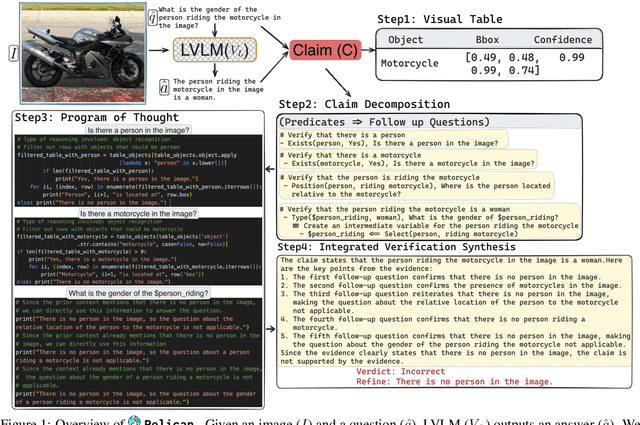
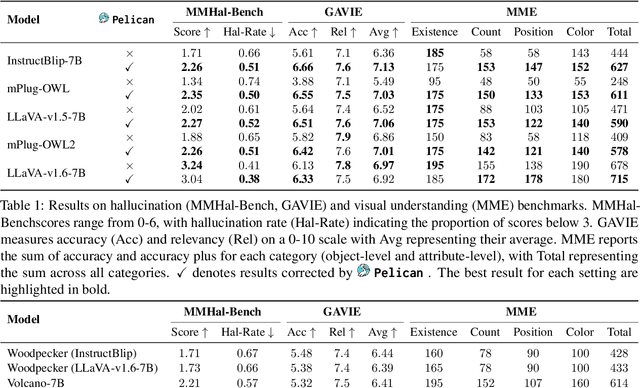
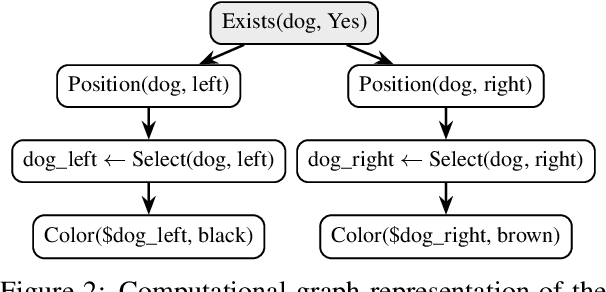

Abstract:Large Visual Language Models (LVLMs) struggle with hallucinations in visual instruction following task(s), limiting their trustworthiness and real-world applicability. We propose Pelican -- a novel framework designed to detect and mitigate hallucinations through claim verification. Pelican first decomposes the visual claim into a chain of sub-claims based on first-order predicates. These sub-claims consist of (predicate, question) pairs and can be conceptualized as nodes of a computational graph. We then use Program-of-Thought prompting to generate Python code for answering these questions through flexible composition of external tools. Pelican improves over prior work by introducing (1) intermediate variables for precise grounding of object instances, and (2) shared computation for answering the sub-question to enable adaptive corrections and inconsistency identification. We finally use reasoning abilities of LLM to verify the correctness of the the claim by considering the consistency and confidence of the (question, answer) pairs from each sub-claim. Our experiments reveal a drop in hallucination rate by $\sim$8%-32% across various baseline LVLMs and a 27% drop compared to approaches proposed for hallucination mitigation on MMHal-Bench. Results on two other benchmarks further corroborate our results.
Empowering Interdisciplinary Insights with Dynamic Graph Embedding Trajectories
Jun 25, 2024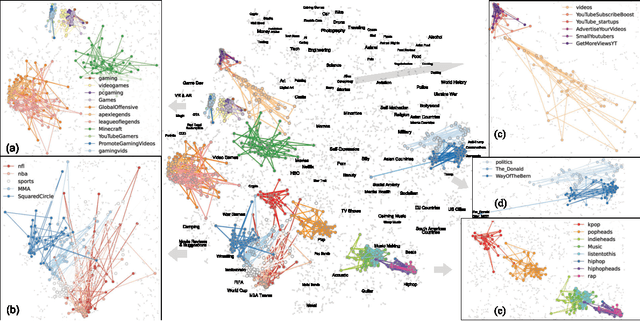
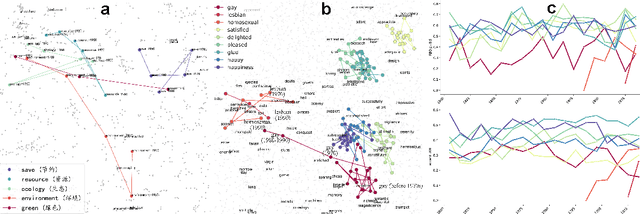

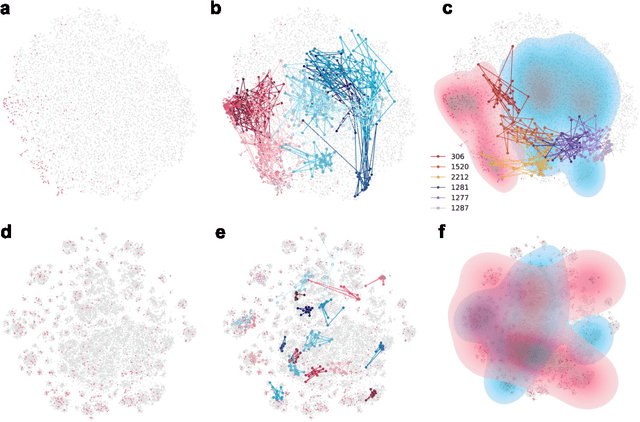
Abstract:We developed DyGETViz, a novel framework for effectively visualizing dynamic graphs (DGs) that are ubiquitous across diverse real-world systems. This framework leverages recent advancements in discrete-time dynamic graph (DTDG) models to adeptly handle the temporal dynamics inherent in dynamic graphs. DyGETViz effectively captures both micro- and macro-level structural shifts within these graphs, offering a robust method for representing complex and massive dynamic graphs. The application of DyGETViz extends to a diverse array of domains, including ethology, epidemiology, finance, genetics, linguistics, communication studies, social studies, and international relations. Through its implementation, DyGETViz has revealed or confirmed various critical insights. These include the diversity of content sharing patterns and the degree of specialization within online communities, the chronological evolution of lexicons across decades, and the distinct trajectories exhibited by aging-related and non-related genes. Importantly, DyGETViz enhances the accessibility of scientific findings to non-domain experts by simplifying the complexities of dynamic graphs. Our framework is released as an open-source Python package for use across diverse disciplines. Our work not only addresses the ongoing challenges in visualizing and analyzing DTDG models but also establishes a foundational framework for future investigations into dynamic graph representation and analysis across various disciplines.
BloomVQA: Assessing Hierarchical Multi-modal Comprehension
Dec 20, 2023Abstract:We propose a novel VQA dataset, based on picture stories designed for educating young children, that aims to facilitate comprehensive evaluation and characterization of vision-language models on comprehension tasks. Unlike current VQA datasets that often focus on fact-based memorization and simple reasoning tasks without principled scientific grounding, we collect data containing tasks reflecting different levels of comprehension and underlying cognitive processes, as laid out in Bloom's Taxonomy, a classic framework widely adopted in education research. The proposed BloomVQA dataset can be mapped to a hierarchical graph-based representation of visual stories, enabling automatic data augmentation and novel measures characterizing model consistency across the underlying taxonomy. We demonstrate graded evaluation and reliability analysis based on our proposed consistency metrics on state-of-the-art vision-language models. Our results suggest that, while current models achieve the most gain on low-level comprehension tasks, they generally fall short on high-level tasks requiring more advanced comprehension and cognitive skills, as 38.0% drop in VQA accuracy is observed comparing lowest and highest level tasks. Furthermore, current models show consistency patterns misaligned with human comprehension in various scenarios, suggesting emergent structures of model behaviors.
A Video is Worth 10,000 Words: Training and Benchmarking with Diverse Captions for Better Long Video Retrieval
Nov 30, 2023



Abstract:Existing long video retrieval systems are trained and tested in the paragraph-to-video retrieval regime, where every long video is described by a single long paragraph. This neglects the richness and variety of possible valid descriptions of a video, which could be described in moment-by-moment detail, or in a single phrase summary, or anything in between. To provide a more thorough evaluation of the capabilities of long video retrieval systems, we propose a pipeline that leverages state-of-the-art large language models to carefully generate a diverse set of synthetic captions for long videos. We validate this pipeline's fidelity via rigorous human inspection. We then benchmark a representative set of video language models on these synthetic captions using a few long video datasets, showing that they struggle with the transformed data, especially the shortest captions. We also propose a lightweight fine-tuning method, where we use a contrastive loss to learn a hierarchical embedding loss based on the differing levels of information among the various captions. Our method improves performance both on the downstream paragraph-to-video retrieval task (+1.1% R@1 on ActivityNet), as well as for the various long video retrieval metrics we compute using our synthetic data (+3.6% R@1 for short descriptions on ActivityNet). For data access and other details, please refer to our project website at https://mgwillia.github.io/10k-words.
DRESS: Instructing Large Vision-Language Models to Align and Interact with Humans via Natural Language Feedback
Nov 16, 2023



Abstract:We present DRESS, a large vision language model (LVLM) that innovatively exploits Natural Language feedback (NLF) from Large Language Models to enhance its alignment and interactions by addressing two key limitations in the state-of-the-art LVLMs. First, prior LVLMs generally rely only on the instruction finetuning stage to enhance alignment with human preferences. Without incorporating extra feedback, they are still prone to generate unhelpful, hallucinated, or harmful responses. Second, while the visual instruction tuning data is generally structured in a multi-turn dialogue format, the connections and dependencies among consecutive conversational turns are weak. This reduces the capacity for effective multi-turn interactions. To tackle these, we propose a novel categorization of the NLF into two key types: critique and refinement. The critique NLF identifies the strengths and weaknesses of the responses and is used to align the LVLMs with human preferences. The refinement NLF offers concrete suggestions for improvement and is adopted to improve the interaction ability of the LVLMs-- which focuses on LVLMs' ability to refine responses by incorporating feedback in multi-turn interactions. To address the non-differentiable nature of NLF, we generalize conditional reinforcement learning for training. Our experimental results demonstrate that DRESS can generate more helpful (9.76%), honest (11.52%), and harmless (21.03%) responses, and more effectively learn from feedback during multi-turn interactions compared to SOTA LVMLs.
Demonstrations Are All You Need: Advancing Offensive Content Paraphrasing using In-Context Learning
Oct 16, 2023



Abstract:Paraphrasing of offensive content is a better alternative to content removal and helps improve civility in a communication environment. Supervised paraphrasers; however, rely heavily on large quantities of labelled data to help preserve meaning and intent. They also retain a large portion of the offensiveness of the original content, which raises questions on their overall usability. In this paper we aim to assist practitioners in developing usable paraphrasers by exploring In-Context Learning (ICL) with large language models (LLMs), i.e., using a limited number of input-label demonstration pairs to guide the model in generating desired outputs for specific queries. Our study focuses on key factors such as -- number and order of demonstrations, exclusion of prompt instruction, and reduction in measured toxicity. We perform principled evaluation on three datasets, including our proposed Context-Aware Polite Paraphrase dataset, comprising of dialogue-style rude utterances, polite paraphrases, and additional dialogue context. We evaluate our approach using two closed source and one open source LLM. Our results reveal that ICL is comparable to supervised methods in generation quality, while being qualitatively better by 25% on human evaluation and attaining lower toxicity by 76%. Also, ICL-based paraphrasers only show a slight reduction in performance even with just 10% training data.
Confidence Calibration for Systems with Cascaded Predictive Modules
Sep 21, 2023
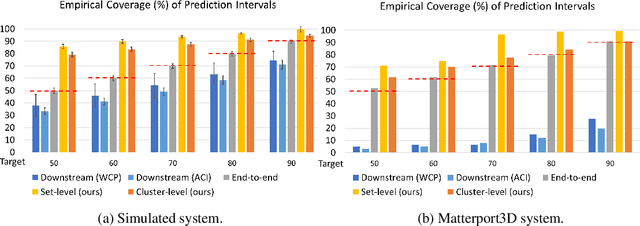


Abstract:Existing conformal prediction algorithms estimate prediction intervals at target confidence levels to characterize the performance of a regression model on new test samples. However, considering an autonomous system consisting of multiple modules, prediction intervals constructed for individual modules fall short of accommodating uncertainty propagation over different modules and thus cannot provide reliable predictions on system behavior. We address this limitation and present novel solutions based on conformal prediction to provide prediction intervals calibrated for a predictive system consisting of cascaded modules (e.g., an upstream feature extraction module and a downstream regression module). Our key idea is to leverage module-level validation data to characterize the system-level error distribution without direct access to end-to-end validation data. We provide theoretical justification and empirical experimental results to demonstrate the effectiveness of proposed solutions. In comparison to prediction intervals calibrated for individual modules, our solutions generate improved intervals with more accurate performance guarantees for system predictions, which are demonstrated on both synthetic systems and real-world systems performing overlap prediction for indoor navigation using the Matterport3D dataset.
Measuring and Improving Chain-of-Thought Reasoning in Vision-Language Models
Sep 08, 2023Abstract:Vision-language models (VLMs) have recently demonstrated strong efficacy as visual assistants that can parse natural queries about the visual content and generate human-like outputs. In this work, we explore the ability of these models to demonstrate human-like reasoning based on the perceived information. To address a crucial concern regarding the extent to which their reasoning capabilities are fully consistent and grounded, we also measure the reasoning consistency of these models. We achieve this by proposing a chain-of-thought (CoT) based consistency measure. However, such an evaluation requires a benchmark that encompasses both high-level inference and detailed reasoning chains, which is costly. We tackle this challenge by proposing a LLM-Human-in-the-Loop pipeline, which notably reduces cost while simultaneously ensuring the generation of a high-quality dataset. Based on this pipeline and the existing coarse-grained annotated dataset, we build the CURE benchmark to measure both the zero-shot reasoning performance and consistency of VLMs. We evaluate existing state-of-the-art VLMs, and find that even the best-performing model is unable to demonstrate strong visual reasoning capabilities and consistency, indicating that substantial efforts are required to enable VLMs to perform visual reasoning as systematically and consistently as humans. As an early step, we propose a two-stage training framework aimed at improving both the reasoning performance and consistency of VLMs. The first stage involves employing supervised fine-tuning of VLMs using step-by-step reasoning samples automatically generated by LLMs. In the second stage, we further augment the training process by incorporating feedback provided by LLMs to produce reasoning chains that are highly consistent and grounded. We empirically highlight the effectiveness of our framework in both reasoning performance and consistency.
TIJO: Trigger Inversion with Joint Optimization for Defending Multimodal Backdoored Models
Aug 07, 2023Abstract:We present a Multimodal Backdoor Defense technique TIJO (Trigger Inversion using Joint Optimization). Recent work arXiv:2112.07668 has demonstrated successful backdoor attacks on multimodal models for the Visual Question Answering task. Their dual-key backdoor trigger is split across two modalities (image and text), such that the backdoor is activated if and only if the trigger is present in both modalities. We propose TIJO that defends against dual-key attacks through a joint optimization that reverse-engineers the trigger in both the image and text modalities. This joint optimization is challenging in multimodal models due to the disconnected nature of the visual pipeline which consists of an offline feature extractor, whose output is then fused with the text using a fusion module. The key insight enabling the joint optimization in TIJO is that the trigger inversion needs to be carried out in the object detection box feature space as opposed to the pixel space. We demonstrate the effectiveness of our method on the TrojVQA benchmark, where TIJO improves upon the state-of-the-art unimodal methods from an AUC of 0.6 to 0.92 on multimodal dual-key backdoors. Furthermore, our method also improves upon the unimodal baselines on unimodal backdoors. We present ablation studies and qualitative results to provide insights into our algorithm such as the critical importance of overlaying the inverted feature triggers on all visual features during trigger inversion. The prototype implementation of TIJO is available at https://github.com/SRI-CSL/TIJO.
Probing Conceptual Understanding of Large Visual-Language Models
Apr 07, 2023



Abstract:We present a novel framework for probing and improving relational, compositional and contextual understanding of large visual-language models (V+L). While large V+L models have achieved success in various downstream tasks, it is not clear if they have a conceptual grasp of the content. We propose a novel benchmarking dataset for probing three aspects of content understanding. Our probes are grounded in cognitive science and help determine if a V+L model can, for example, determine if snow garnished with a man is implausible, or if it can identify beach furniture by knowing it is located on a beach. We have experimented with 5 well known models, such as CLIP and ViLT, and found that they mostly fail to demonstrate a conceptual understanding. That said, we find interesting insights such as cross-attention helps learning conceptual understanding. We use these insights to propose a new finetuning technique that rewards the three conceptual understanding measures we proposed. We hope that the presented benchmarks will help the community assess and improve the conceptual understanding capabilities of large V+L models.
 Add to Chrome
Add to Chrome Add to Firefox
Add to Firefox Add to Edge
Add to Edge